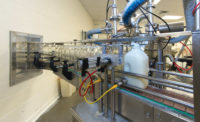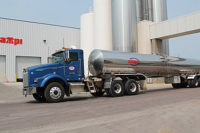A more efficient way to concentrate milk

Powdered milk is a vital ingredient in infant formula and also used in a wide a range of baked goods and confectionary products. It is manufactured using an energy-intensive process chain that involves concentrating and drying milk, according to a press release from the Technische Universität München (TUM) in Munich, Germany.
Researchers there are researching more energy-efficient ways of making concentrates. And they are already seeing promising results: By combining different membrane separation processes, they have succeeded in reducing the amount of energy required to concentrate milk by around 20%.
Almost half of the milk produced in Germany is turned into milk powder. This corresponds to about 830,000 tons per year. Twenty-five percent of the energy consumed by the milk industry is used in the production of powdered milk and whey. TUM researchers have been looking at ways of saving energy at the different process steps in the powder production chain.
During this process chain, milk and whey are initially concentrated to around 10% of their original volume. In addition to using the conventional method of heating and evaporating the dairy products, the industry also deploys membrane separation processes such as reverse osmosis and nanofiltration. The remaining water in the concentrate is then removed by drying. Despite the very small amounts of water left at this stage, drying can account for 50% of the entire energy consumption bill.
Separation instead of evaporation
The researchers have already shown that a lot of energy can already be saved during the preliminary concentration stage.
“Reverse osmosis and nanofiltration can cut energy consumption by a factor of two or even four compared with regular evaporation methods,” explained Professor Ulrich Kulozik, the project leader and the TUM Chair of Food Process Engineering and Dairy Technology.
These two processes work with special membranes that allow water to pass through while retaining almost all constituents in milk and whey. One drawback, however, is that the concentration of dissolved substances such as salt and lactose increases as more water is removed. Proteins also “block up” the membrane and reduce the amount of water being removed.
“As a result, we can only achieve a dry mass of up to 35% using reverse osmosis,” Kulozik said. “What we really want is a higher percentage of dry matter as this reduces the amount of water to be removed in subsequent evaporation and drying steps. This would further cut the energy consumed in the initial concentration stage.”
To obtain a thicker concentrate, however, manufacturers would have to work with a higher pressure, which in turn would require more energy. Prof. Kulozik and his team have been able to solve this problem by combining three different membrane separation processes: ultrafiltration, reverse osmosis and nanofiltration.
Researchers first use ultrafiltration to remove proteins from the liquid. The dissolved constituents can then be concentrated using reverse osmosis and nanofiltration. Removing the proteins in this way speeds up reverse osmosis and nanofiltration by a factor between two and five. This combination of reverse osmosis and ultrafiltration is 20% more energy efficient than reverse osmosis on its own. The proteins and dissolved constituents can be recombined at a later stage in the process chain.
The TUM team was also able to double the amount of dry matter produced by cascading ultra- and nanofiltration processes in series.
“We were able to show that the right combination of membrane separation technologies can unlock significant efficiency gains in powdered milk and whey production,” Kulozik said. “Our aim here is to obtain the highest possible concentrations of milk before evaporation and drying.”
Milk powder has a shelf-life of up to two years. Milk concentrates, however, can only be kept fresh for a maximum of 10 days – until now. The researchers at TUM are also looking to extend this storage period. “We are exploring various heating processes for concentrates with a view to extending the shelf-life for milk concentrate so that it becomes an attractive alternative to powder in the future,” Kulozik said.
The researchers have been able to store concentrates with 30% dry matter content for several weeks at a time at temperatures below 10 degrees Celsius without impacting on the product quality.
“One of the main benefits of concentrates is that they are still liquid and so they do not need to be dissolved in water again,” he said. “And because there is no drying process involved, they also deliver significant energy and cost savings.”
Kulozik’s team is collaborating with Prof. Martin Grunow’s chair Production and Supply Chain Management to investigate the benefits of concentrates. They are evaluating the value potential of concentrates relative to powders, and also assessing the market needs and logistics required within the industry. Here the spotlight is on sustainability and climate footprint and the teams will be using ecological balance software to measure the performance of the different technologies. Two companies from the dairy industry are also working with the TUM teams on this subproject.
—Contributed by the Technische Universität München (TUM), Munich, Germany.
Looking for a reprint of this article?
From high-res PDFs to custom plaques, order your copy today!







